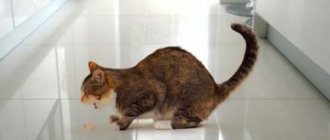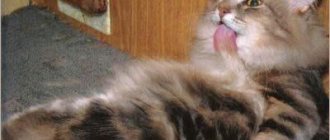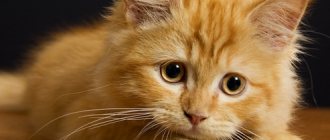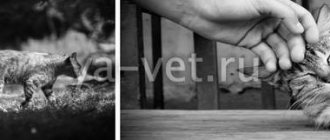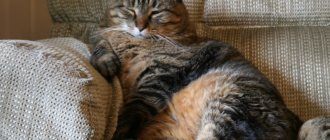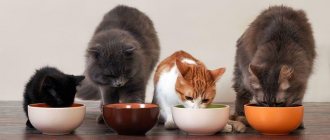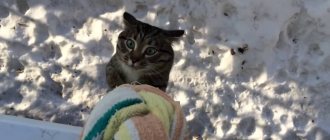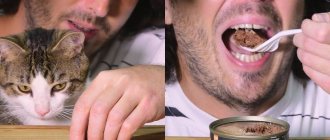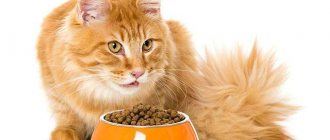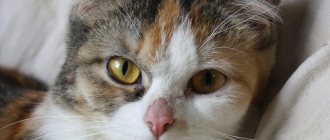We are accustomed to associate any digestive problems with food eaten shortly before. And if a cat vomits after dry food, the owner involuntarily begins to doubt the correctness of the selected diet. In fact, one-time vomiting in the absence of other symptoms is not a cause for alarm and can be caused by a variety of reasons.
Do not rush to switch your pet to another brand of food, especially to a different type of food. Some factors that provoke vomiting can be easily eliminated without radical changes in the menu.
What could be the causes of vomiting?
The following reasons are possible if a cat vomits undigested food.
Haste when eating
A cat vomits fur every day: what to do?
Due to habit, cats may eat hastily but drink little. Lack of fluid in the body leads to vomiting. In this case, add a little water to the food. But you shouldn’t wait for the granules to swell, as the cat may not even like such a treat.
Note! Food diluted with water will swell greatly in the stomach. Therefore, standard portions need to be slightly reduced.
Binge eating
Can a cat vomit after eating dry food? Cats do not have a stopcock that will stop them when their stomach is full. They will eat as much as is in the bowl. When overeating, the pet’s stomach does not have time to stretch to accommodate the incoming volumes of food and gets rid of the excess in a simple way.
This phenomenon is especially often observed among owners of several pets, between whom there is a fight for food. Everyone tries to snatch a bigger piece for themselves and no longer cares about the amount of food.
Important! After vomiting, the cat may ask for food again. In this case, it is necessary to limit food intake. It is important that your pet chews the food and not swallows it.
Poor quality diet
If a cat is kept on economy class or cheap food, vomiting is a completely predictable phenomenon. To assimilate the food received, the animal’s body must have enough complete protein. If a cat vomits food, the reason may lie in the lack of this particular element. Cheap food contains very little meat; it is replaced with offal. Also, the preservatives and additives included in the food negatively affect the stomach, causing vomiting.
Important! You should not keep your pet on dry food all year round; it also needs natural food. Food waste from the table is not considered a natural product, since some of it can cause even greater harm to the pet.
Component intolerance
Why does a cat vomit after dry food? She may have allergies or intolerance to the components of the food, especially if it is cheap. Wheat or corn is added to many of these foods.
Vomiting can also be caused by a change in diet, so the body gets used to new foods.
Types of vomiting in cats
First, let's talk about physiological vomiting, which is not dangerous to your pet's health. It could be:
- Vomiting from eating grass - cats use it to cleanse the body. If a cat ate green grass and vomited green grass, then this is normal and even healthy. However, sometimes cats quite successfully digest all the grass, and if they eat it, this does not mean that vomiting will soon begin.
Cats love green grass, with which they cleanse their bodies and replenish their supply of vitamins.
- Vomiting from psychological trauma - Some cats may react by vomiting to moving, rearranging furniture, or introducing a new pet into the house. Knowing this characteristic of a cat, it is better not to feed the animal on this day or reduce the amount of food - this will help prevent an unpleasant reaction from the cat’s body.
- Vomiting from motion sickness during long trips is quite common in cats. To prevent such vomiting, you can use mild herbal-based sedatives, and do not feed your pet for 7-8 hours before the trip.
- Vomiting from eating inedible objects - some cats tend to swallow threads, pieces of plastic, candy wrappers, hair ties and even small toys. As a rule, in such animals vomiting occurs easily and frees the body from inedible objects. However, if difficulties or symptoms of difficulty breathing occur in a cat with such vomiting, you should immediately consult a doctor.
- Vomiting from swallowing fur - sometimes cats get nervous and lick their fur especially actively, after which they may even develop bald spots on their stomachs. To facilitate the removal of fur from the body, there are special vitamins and treats, and you can also help the cat by introducing a teaspoon of petroleum jelly into the mouth.
Similar products can be used for cats of any kind, especially long-haired breeds, which often tear their hair.
Non-dangerous vomit is most often transparent, with visible and understandable contents: wool, grass, threads, pieces of food.
Vomiting after eating undigested food or dry food
This is a typical type of vomiting seen in domestic cats. The rapid pace of food absorption, large volumes and poor chewing lead to the fact that the stomach does not have time to stretch and throws the contents back. The cat may vomit immediately near the bowl or a few minutes or even half an hour after eating. The animal can then return to the bowl and ask for food again. There is only one way out - limit food portions. Dry food must be chewed so that you can hear how its pieces crunch. If the animal swallows them whole, then the likelihood of vomiting increases greatly. In addition, when washed down with water, the food actively swells in the stomach, so initially the cat needs to eat much less.
Eating greedily and quickly is the most common cause of vomiting in cats.
The author of the article has a beloved old cat of the Thai breed, which is already 17 years old. In the last 3-4 years she has been vomiting quite often, and we are very familiar with this problem. About 1-2 times a week she regurgitates dry food, which she previously swallowed without chewing. She has special, premium food, designed for good digestion, the pieces are not very hard, they are easy to chew. But the cat already has very bad teeth, so from time to time, when she is too lazy or has no time to grind the pieces, she eats them quietly, quickly and without any crunching. This process is also influenced by the presence of a second animal in our house, a young and healthy cat, who eats completely different food from his bowl nearby (for young castrated males), but looks towards the cat in order to move it away from the feeder and eat everything that lies there. Usually we follow this process and do not allow the cat to eat someone else’s food, but sometimes we get distracted and see the final scene: the cat walking away from its bowl and the cat finishing the food behind it. Therefore, the cat periodically eats greedily, quickly, without chewing, after which after 10–15 minutes, maximum half an hour, it begins to slurp and lick its lips, then runs to the floor, coughs there, and it is on the carpet (favorite place) that the entire contents of breakfast or dinner are thrown out. It looks like slightly overcooked (rarely) or not chewed food at all (usually). The cat feels guilty and immediately hides. Sometimes she doesn’t have time to reach the floor and vomits right on the bed where she sleeps. I have to clean up piles of food after her and wash her beds. It's not scary, but it's unpleasant. This happens about once a week. If you feed your cat wet food of the same line, there will be no vomiting, because it is soft and well crushed. Usually after a bout of vomiting I feed her a little less than usual. But we must give the cat his due; after burping, she never returns to the bowl and asks for more food. She arranges a diet for herself for 3-4 hours, and only then intensively asks to eat. Sometimes after an attack of vomiting he goes to a bowl of water and drinks a lot. The funny thing is that the cat, when he was young, tried to eat the food that she regurgitated. Now he has wised up and doesn’t do that anymore. Sometimes a cat also vomits hair, but this happens very rarely, about once every 2-3 months, during periods of active shedding. A young cat also vomits, but very rarely and never with food. He has two problems - vomiting grass when he eats too much, and vomiting foam with fur during active shedding. But since a cat licks itself much less than a cat, it also vomits its fur literally a couple of times a year and little by little. And the pet regurgitates the grass in the warm season, when we walk with him on a harness, and he absorbs the grass in the quantities his body needs. It can be concluded that young cats have far fewer problems with vomiting than older cats. And it is better to switch old cats to wet food, this will serve as a preventive measure against vomiting.
Vomiting yellow liquid (bile)
Vomiting bile means that the animal has not eaten for more than 24 hours or the contents of the stomach have previously been completely released into the environment. Bile is released from the small intestine, liver, and duodenum. This is usually a sign that the cat is hungry and not feeling well, often accompanied by lethargy and lack of appetite. In this case, it is better to show the animal to a veterinarian.
If, in addition to vomiting, the animal has a lack of appetite and a lethargic state, then you need to take it to the veterinarian for examination as quickly as possible.
If the bile is dark yellow in color, it may be hepatic vomiting associated with a foreign body inside the body or parasites.
Persistent, repeated vomiting of bile in a pet may indicate chronic diseases of the gallbladder, liver or intestines. Fatty or stale food, overeating and swallowing large pieces of food can provoke an exacerbation.
Vomiting white foam
The appearance of white foam means hungry vomiting, which is formed due to the secretion of juice in an empty stomach. To protect the mucous membrane from an aggressive environment, a special protein is produced in the stomach, which comes out in the form of white foam.
This occurs due to long-term fasting, the presence of parasites, gastritis, chemical poisoning, etc. Vomiting with white foam, occurring 1-2 times while maintaining appetite, is not considered dangerous, but if there was more urge to vomit, it is reduced or There is no appetite, and the animal’s condition is causing concern, then a doctor’s consultation is required.
Kitten vomiting
Vomiting in kittens is very dangerous and the younger the baby is, the less chance of saving him even with qualified medical care. Dehydration has a detrimental effect on kittens and can quickly lead to death. Most often, vomiting at an early age indicates congenital disorders of the digestive system or low-quality mother's milk. Difficulties in treating cubs are associated with the unpredictable effects of drugs on the young body.
Kittens from 3 months of age are considered as adult animals and the same treatment methods are applied to them.
Other types of vomiting
Vomiting blood is considered the most dangerous and always requires medical intervention. Most often, it indicates a viral infection or an exacerbation of a peptic ulcer. Also, persistent, prolonged vomiting can cause small vessels in the digestive tract to burst. Brown blood is undigested blood, which means liver dysfunction or other dangerous diseases, so the owner of the animal will need to take urgent measures in order not to lose the pet - it must be taken to a veterinary clinic as quickly as possible.
Green vomit means problems with the pancreas, blockage of the gastrointestinal tract, which is often observed with infectious and viral diseases.
Video: Vomiting in cats - veterinarian advice
What symptoms require you to go to the clinic?
If the cat vomits food once, it is too early to panic. You should pay attention to the pet’s condition: whether its eyes are shiny, whether its nose is cold, what mood it is in - lethargic or active. Perhaps everything is fine with your health, but vomiting is caused by overeating.
How much dry food does a cat need per day: table
If a cat vomits food regularly, it is accompanied by poor health and impurities of blood or bile in the rejected masses, the animal should be taken to a doctor for examination. Especially if the vomit is yellow or green.
If this cannot be done in the near future, you should provide first aid yourself. It consists of limited consumption of water and food: the latter is fed in small pieces every 2 hours. Only easily digestible foods are suitable: boiled chicken, cottage cheese or baby food.
Important! Don't put off going to the clinic. Regular vomiting can be a signal of dangerous diseases.
Urgent medical attention is required if:
- vomiting continues for more than a day;
- the pet refuses food and water;
- the rejected masses contain admixtures of mucus or blood;
- The cat’s well-being and mobility deteriorate.
Binge eating
Cat vomits after dry food from “greed”
Rapid, greedy absorption of food can also cause vomiting, because with such zeal too much air is swallowed, which fills the stomach and prevents normal digestion of food. Of course, dog owners are more likely to encounter this problem, because these animals have developed an instinct to eat quickly, because, as they say, in a large flock “they don’t snap their beaks.” But single cats can also find themselves in a situation where they need to eat food as quickly as possible, for example, if there are several pets, and among them there are those who strive to encroach on the contents of their neighbor’s bowl.
It is best to divide the dining rooms for cats, if not into different rooms, then at least into different corners or levels, for example, feed one on the floor, another on the windowsill, etc.
What to do if your cat vomits after eating undigested food
A cat vomits food once - this is an incident that is unlikely to pose a threat. Repeated situations require medical intervention.
Feed your cat more often, but with less food
The volume of a cat's stomach is small. Rather than overloading it with huge portions 1-2 times a day, it is better to feed it 4-5 times a day in small portions. This way the pet will be full and not overeat.
What to feed the cat in this case
What to feed a cat after vomiting? Switching to other dry foods will not always bring results, and may even worsen them. A sick pet is gradually fed with natural products: boiled chicken, cottage cheese, baby food.
But you should not immediately switch the animal to natural products after low-quality semi-finished products, since a sudden change in diet will negatively affect the pet’s already poor health.
Doctor
Burps food
Cats who eat only dry food often burp almost immediately after eating. When dry food mixes with the contents of the stomach, it expands and causes discomfort.
Something as harmless as a form of dry food can cause spit up. Try different forms of dry food to see if your kitten can handle pellet-shaped food versus star- or square-shaped kibble.
© shutterstock
Preventive measures
Compliance with preventive measures will avoid the problem of indigestion of food. What to do?
- The pet should always have access to clean water, especially if the diet is dry;
- You shouldn’t skimp on your pet’s health; its stomach needs high-quality nutrition. It is better to give him premium food;
- It is better to divide feeding into 4-5 times in small portions, so the cat will not overeat;
- worm your pet regularly, as worms and parasites also interfere with digestion;
- it is also necessary to choose the right food in accordance with the breed, age and condition of the pet;
- Be sure to regularly visit the veterinarian and carry out preventive vaccinations.
Important! You cannot give your pet medications or treatment on your own without a doctor’s recommendation. The owner may incorrectly determine the diagnosis, and attempts to save the pet will only hasten its death.
Natural product
If your cat vomits from food, you should get treatment as soon as possible. Rather than putting off going to the doctor or hoping that it “will go away on its own,” it is better to take measures as soon as possible so that the pet will delight its owner with its love and health for a long time.
Food intolerance
This condition develops due to the inability of the body's enzyme system to digest one or another component of dry food. As a rule, it occurs immediately upon a new diet and is accompanied not only by vomiting, but also by diarrhea. Is food intolerance a signal for an immediate diet change? Not always.
Very often, the pancreas simply needs time to adapt to the new diet and begin producing enzymes in the required quantities. For example, if your cat previously ate dry food with a low meat content for a long time, and now you decide to switch it to a diet with a large amount of meat ingredients, then naturally the stomach cannot digest it right away. That is why it is recommended to make the transition to a new diet gradually, gradually mixing the new food into the old diet and increasing its share every day until complete replacement.
In some cases, the process may be helped by taking enzyme preparations as prescribed by a veterinarian. You should also consult with him if the transition is carried out correctly, but the vomiting does not stop, in order to identify the component causing food intolerance and avoid it in the future.
Don't start the disease!
Vomiting can be a symptom of a large number of diseases, primarily acute poisoning, foreign body entering the stomach due to accidental ingestion, diseases of the gastrointestinal tract, liver, and pancreas. It often accompanies various infections, many of which pose a danger to the life of the animal. Therefore, if vomiting recurs constantly or very often, then you need to consult a doctor so as not to start the disease. In this case, you should immediately prepare yourself for a serious examination - taking tests and following all the specialist’s instructions.
Uncontrollable (incessant) vomiting, accompanied by a sharp deterioration in the pet’s well-being, is a reason not only to contact, but to immediately run to the doctor, because such acute conditions require immediate, sometimes surgical, intervention.
Hairballs, or bezoars
The problem affects all cats, but more so long-haired ones. As a result of daily licking, they swallow too much hair, so that it cannot be eliminated naturally, but accumulates in the stomach and intestines, forming dense clumps. When the stomach is empty, the cat may not be bothered by anything, but as soon as it eats, the volume of the stomach, along with the bezoars, increases so much that normal digestion becomes impossible and vomiting occurs. Regular brushing of your pet will help to cope with this problem, as well as special pastes for hair removal, which it is advisable to give at least once a month, and more often during the molting period.
